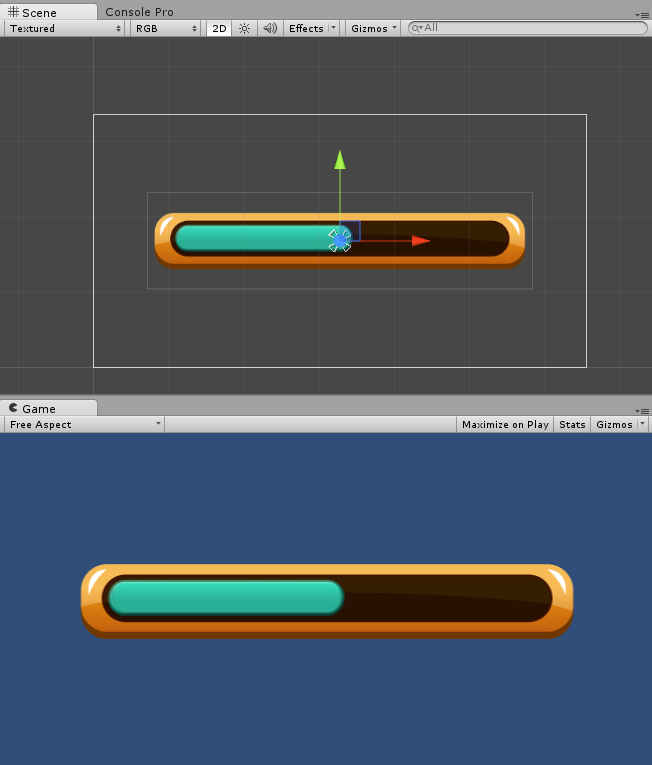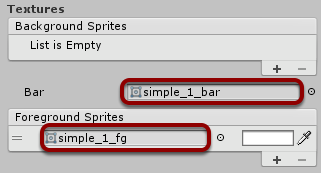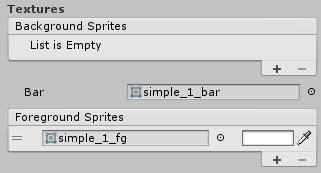Introduction
uGUI Sliced Renderer is a uGUI renderer that allows you to create bars similar to these known from Filled renderer type but the bar itself instead of being cut, it is stretching based on sprite border settings.


Usage
You can create new uGUI Filled Renderer in three ways:
- Select Game Object → UI → Energy Bar Toolkit → Sliced Bar from the main menu
- Select Tools → Energy Bar Toolkit → uGUI → Create Sliced Bar from the main menu
- Click on the
 button in Hierarchy window, then UI → Energy Bar Toolkit → Sliced Bar
button in Hierarchy window, then UI → Energy Bar Toolkit → Sliced Bar
Either way, you will see a new shining bar on your scene:

This component is created in a way to display something as soon as possible. By default it’s setup using bundled sprites that you probably would want to change:

Configuration
In order to make things easier Inspector of Energy Bar Renderer is split to 4 different sections.
Textures
Here you can setup your textures.

You are allowed to add any number of background and foreground sprites. To add a new sprite just click the + (add) button and you can remove it by selecting it and then pressing the - (remove) button. For each texture you can also decide about its tint. The tint of the Bar texture is configurable in the Appearance section.
- Background Textures – These sprites will be placed under the Bar texture.
- Bar Texture – Texture of bar itself. It must have the border set properly.
- Foreground Textures (optional) – These sprites will be placed on top of the Bar texture.

Setting the border
Before you can use your bar texture in Sliced Renderer you have to set its border correctly. Setting border means that you have to separate the part of texture that can be stretched from the part that cannot.
To edit the sprite border, select your texture in the Project view and then click on the Sprite Editor button. ![]()
In newly opened window you can now set the border (green lines).
![]()
Make sure to separate parts that can be stretched from parts that shouldn’t.
![]()
Appearance

- Set Native Size – Click on this button to resize your bar to it’s native size based on used sprites.
- Bar Color Type – Here you can select how to colorize your bar
- Solid – One solid color.
- Gradient – Color that changes over bar value.
- Grow Direction – Which direction bar should increase to. Possible grow directions:
- Left To Right
- Right To Left
- Bottom To Top
- Top To Bottom
- Expand Horizontal – Expand horizontally starting from the middle
- Expand Vertical – Expand vertically starting from the middle
- Color Change – Always full fill, changes only bar color.
- Min Size – Minimal allowed bar size in pixels
- Bar Scale – Bar texture scale
- Bar Offset – Bar texture offset in pixels
- Label – Choose the uGUI Text object to be used as your bar label.
- Label Format – Format of the label. See description below.
Label Format Description
- {cur} – current int value
- {min} – minimal value
- {max} – maximum value
- {cur%} – current % value (0 – 100)
- {cur2%} – current % value with a precision of one decimal place (0.0 – 100.0)
Examples
- {cur}/{max} – 27/100
- {cur%} % – 27 %
Effects

You have an access to variety of visual effects.
Smooth Effect
Makes the bar smoothly change its value.

- Speed – Effect speed.
- Direction – When the smooth effect should be visible. The options are Only When Decreasing, Only When Increasing, and _Both.
- On Finished – Specify a object that message should be sent to, when the smooth effect finishes its animation. After assigning the object, you will be able to specify the method name as well.
Burn Effect
Shows the value burn effects. Similar to smooth effect, but displays the bar “shadow”.

- Bar Texture – You can assign a sprite here if the texture should be different that currently used Bar texture.
- (Tint) – (Not labeled) Even if you won’t specify the texture, use the tint to change your burning bar color.
- Direction – When the smooth effect should be visible. The options are Only When Decreasing, Only When Increasing, and _Both.
- Speed – How fast this animation will be progressing. (This property is shared with Smooth Effect)
Blink Effect
Makes the bar blink when certain value has been reached.

- Operator – Can be Less Than, Less Or Equal, Greater Than, and Greater Or Equal.
- Value – The comparsion value.
- Rate – The blinking rate.
- Color – The blinking color. In most cases you will want to set it to fully transparent.
If Operator is set to Less Than and Value to 0.2 bar will blink only when your bar value will drop under 20%.
Debug
The debug section exists for mainly for debugging purposes. If you’re advanced Unity user and/or you will be having troubles of understanding the workings of Energy Bar Toolkit, then enable the debug mode. In debug mode Energy Bar Toolkit reveals all hidden game objects, that normally shouldn’t be seen or modified.
